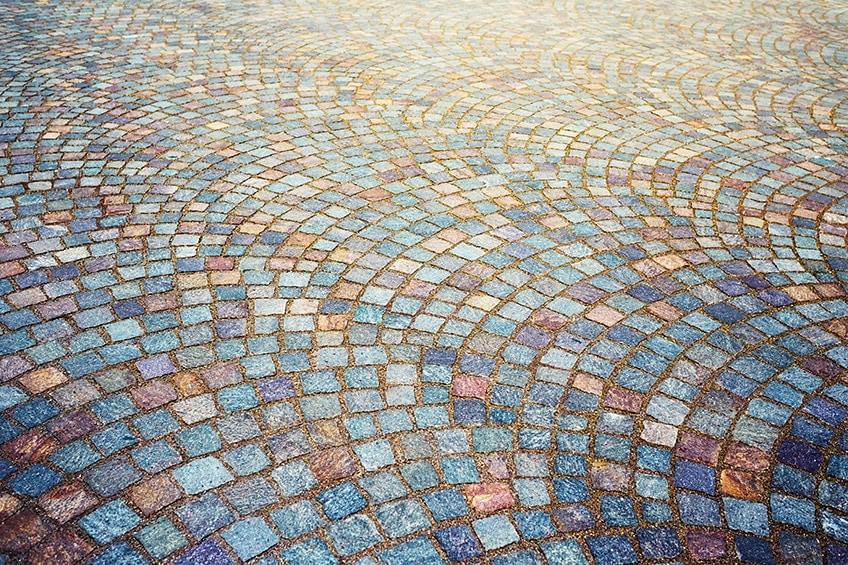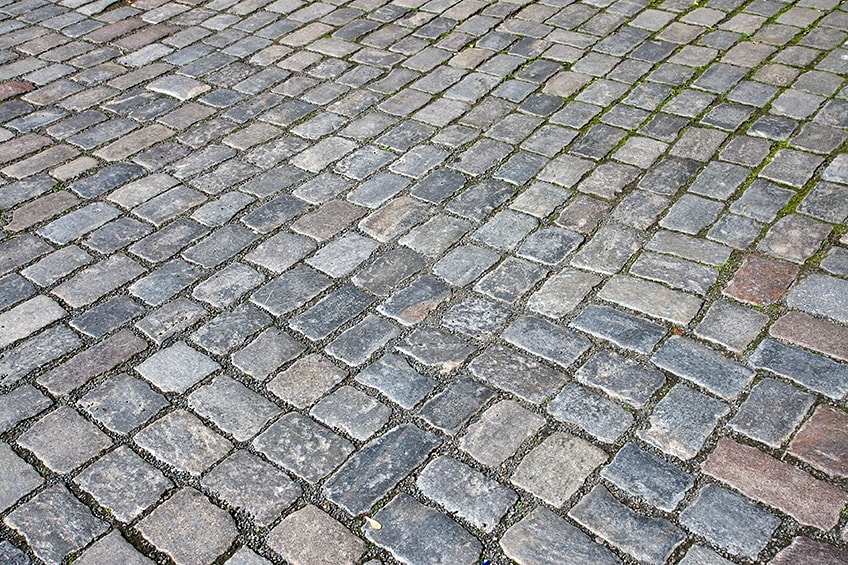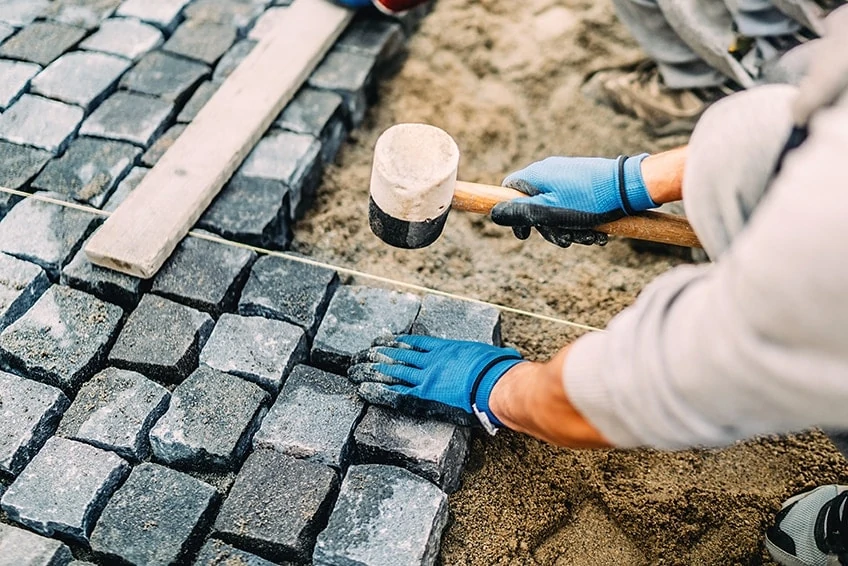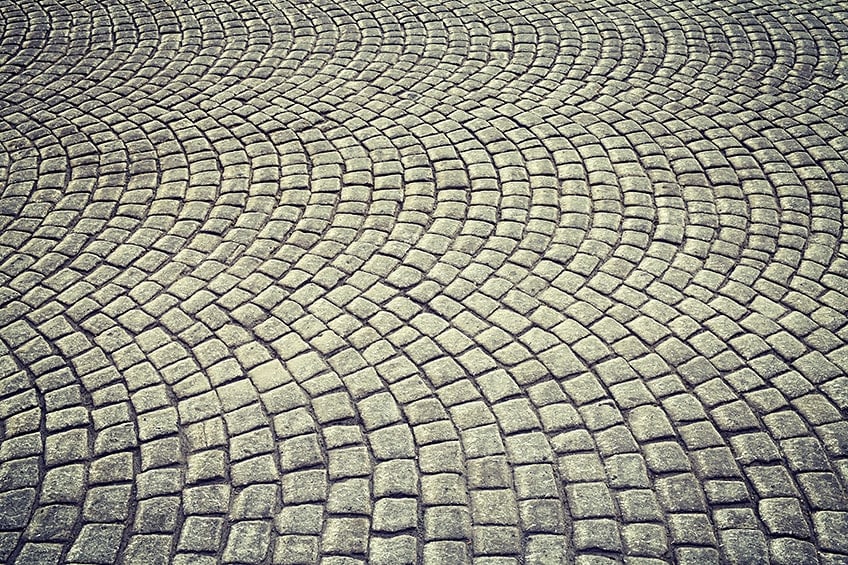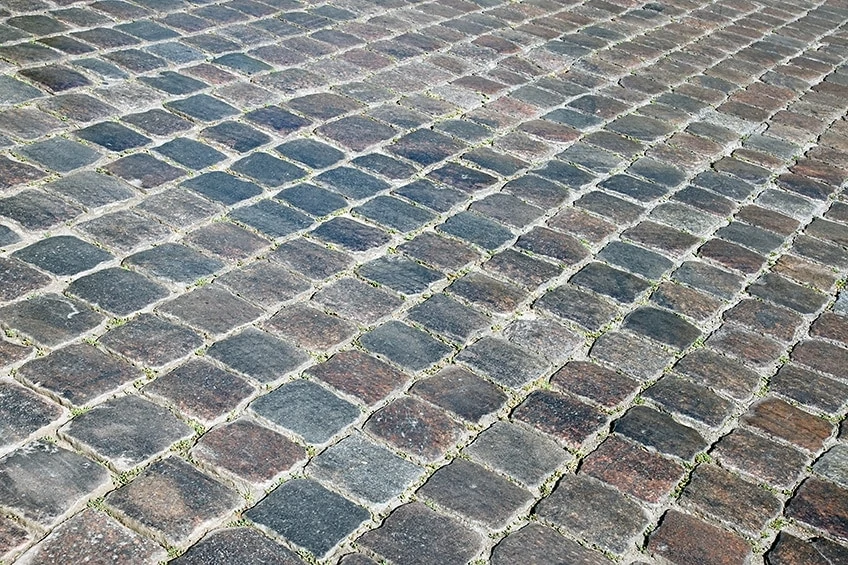Epoxy Grout for Paving Stones – Creating Professional Pavement Joints
This post may contain affiliate links. We may earn a small commission from purchases made through them, at no additional cost to you. You help to support resin-expert.com
Cobblestones are the ideal substrate for heavily trafficked areas. Therefore they are very popular especially in driveways. However, they must of course be grouted. This can be done either classically with chippings and sand or in the modern way – with synthetic resin grout. In the following, we will tell you how to grout your paving stones very simply with epoxy resin.
Table of Contents
What is Epoxy Resin Grout?
Epoxy resin jointing mortar is based on a synthetic resin and has almost completely replaced traditional jointing mortars today. Epoxy resin jointing compound consists of two components and is considerably more expensive than the former jointing mortars, but is also much more durable and resistant.
The application is not quite as easy, but the financial investment as well as the increased workload is worthwhile.
Advantages and Disadvantages of Epoxy-based Grouts
Compared to classical jointing mortar, an epoxy resin-based grout has several advantages:
Pros
- Jointing mortar on the basis of epoxy is extremely durable.
- It effectively protects the ground against regrowing weeds.
- It is elastic and adapts optimally to the weather-related expansion fluctuation of the substrate.
- If the grouting work has been carried out properly, the epoxy grout is water permeable.
- Epoxy jointing compound ensures perfect stabilization of the paving stones.
- It can be used for heavily loaded substrates and withstands the loads better than quartz or sand.
Cons
- It is considerably more expensive than classic jointing mortar.
- An unattractive veil of synthetic resin may appear on the paving stones – this usually dissolves by itself after a few months in outdoor areas, but must be removed mechanically indoors
Despite these two disadvantages, epoxy grout is the first choice when it comes to grouting paving stones in a durable and above all permanently weed-free manner. The high price is outweighed only by the durability of the material and the saving of additional working time for weeding.
Different types of Epoxy Pavement Grout
If you want to grout paving stones with epoxy resin, you have the choice between two different systems: the one-component and the two-component grouts. Both have different characteristics, which we will discuss in the following chapters.
1k Jointing Mortar
If you want to grout paving stones with epoxy resin, you must consider the load to which the surface to be grouted is exposed before starting work. If it is a pedestrian path, you can use one-component epoxy mortar. This is because it is not quite as strong as a two-component system.
Recommendation: Jennifer’s Mosaics White Powdered Grout 1K Jointing Mortar
Our recommendation for a one-component jointing mortar is Jennifer’s Mosaics White Powdered Grout. As mentioned above, it is not as resilient as a two-component system, but it can score with other positive properties:
Pros
- 1k Epoxy grout is suitable for many substrates, such as ceramic terraces and all tile work
- The application is extremely simple, as only one component has to be applied; nothing has to be mixed, because after application the next downpour does the rest
- The epoxy mortar has a self-compacting effect and therefore does not have to be re-compacted manually
- The epoxy grout has a good water permeability and fights weeds effectively
- The one-component epoxy resin mortar can be applied even in light rain
- Even narrow joints can be processed with it without problems
- It is available in different colours, so that it can be selected to match the respective floor covering
Cons
- He has, of course, a proud price
- Its processing can only take place within a certain temperature range; this lies between +5° and +25° C soil temperature
- It is hardly possible to remove the paving stones after grouting
- This grout provides hard, uniformly colored, wear-resistant joints with greater bond and compressive strength than other grouts.
- Use in bathrooms, on kitchen backsplashes, arts and craft projects, or any outdoor tile work.
- Use some now, keep some for later. This plastic tub comes with a lid, don't worry about having an open bag of grout lying around.
The Jennifer’s Mosaics White Powdered Grout 1k epoxy resin grout has so many advantages that we can fully recommend it despite the disadvantages mentioned above.
2k Jointing mortar
2K Epoxy Jointing Mortar is characterised by two components that must be mixed together before work can begin. It is essential to maintain a perfect mixing ratio, otherwise there is a risk of insufficient curing. This makes the grouted surface less loadable and prevents it from developing its other positive properties such as protection against weeds. Fortunately, today’s two-component systems generally make mixing very easy for the user.
Recommendation: SpectraLOCK Pro Premium Grout 2-Component Jointing Mortar
Our second recommendation for an epoxy resin jointing compound is the two-component version of vdw, namely VDW 815 Plus. This is characterised by excellent properties:
Pros
- It has a high flowability
- Although it consists of two components, it is easy to mix
- The jointing is durable and very resilient
- The jointing mortar can already be used for a joint width from 3 mm
- The paved areas remain clean or can be easily cleaned with a special cleaner
- The epoxy resin grout has a high water permeability, but acts reliably against weeds
- It is, like the one-component system, self-compacting
- The epoxy jointing compound has good flowability and, after curing, is resistant to vacuum sweepers and abrasion
- It also has a high frost resistance and is environmentally friendly
- The compound can even be processed in light rain
- Even in comparison to classical material this joint sealant is still relatively inexpensive
Cons
- The pot life is relatively short, so work must be done very quickly; as an alternative, weigh the components separately and always mix only a small amount
From us there is a clear recommendation due to the large number of advantages!
Suitable areas of application of 2-Component Joint Mortar
The areas of application for epoxy resin jointing mortars are manifold. So you can use it for
- Work areas
- Bathroom for Tiles
- Inputs
- Terraces
- Garden and footpaths
- Entrances
use. However, note the following: Single-component systems are much less resilient than two-component systems. Therefore, in places that have to withstand high loads, such as driveways, you should always use a 2k epoxy resin grout.
Important to note when grouting
- When grouting with epoxy resin grout, it is important to maintain a gradient of at least two percent of the total surface. In addition, the substrate must have a solid base of gravel, crushed stone, sand or gravel, otherwise the joints would not be able to withstand the loads from pedestrians or even cars.
- You should not slurry the epoxy resin grout, as this has no positive effects on the material.
- The great advantage of epoxy grout is the fact that it is not rigid, but flexible. This prevents cracking in the joints, so that the epoxy resin mortar can also be used for unbound bedding layers. However, in this case you should first use a joint filler and apply it up to at least two thirds of the joints. After this, the actual epoxy mortar is used.
- Epoxy mortar can be processed either water-permeable or water-impermeable and can even serve as drainage.
Instructions for Plaster grouting with Epoxy Resin
You don’t have to be a professional to grout plaster with epoxy resin. You only need to have the necessary equipment and observe a few basic things. Simply follow our step-by-step instructions below for grouting paving.
You need the following things:
- The epoxy resin-based jointing compound
- A suitable stirrer, for example a drill with a stirrer basket
- A hose with water connection and spray gun
- A hard rubber slider
- A coconut broom
Prepare joints
- If you want to repair an already existing surface, the joints must first be cleared out. You can easily do this using a high-pressure cleaner.
- Clean the joints thoroughly to a depth of at least three centimetres. The surface of the paving stones should also be freed from dirt and dust in this way.
Mixing the grout
- As a rule, both components are supplied in perfect mixing ratio. For the sake of simplicity, you can mix the complete mixture, but please note the pot life. Empty the bottle in the bucket completely into the bucket. Depending on which epoxy mortar you use, you will then have to fill the bottle up to twice with water, which you also pour into the bucket. Refer to the data sheet provided, which is located under the bucket lid.
- Stir thoroughly. Make sure that the mixture is also thoroughly mixed on the side walls and the bottom. Stir until a free-flowing mixture is obtained.
- Now the pot life begins, i.e. the time in which you can process the compound before it hardens. It is now important to work quickly and effectively.
Incorporate mixed jointing compound
- The area to be grouted must now be watered to saturation. Using the water hose, apply a generous amount to the entire surface. The following applies: Not too much water can be used, only too little. It is therefore better to spray more liquid.
- Then empty the complete bucket onto the paving stones. Slide the mixture into the joints using the hard rubber slider. Always work diagonally to the joint so that the compound is distributed optimally in the grooves and fills them. Use the highest point of the surface so that you work in the direction of the slope. Depending on the epoxy resin mortar used, you will need to water generously using the water hose. This can also be found in the data sheet.
- From time to time you should clean the soles of your shoes with the water jet to avoid footprints on the paving stones.
Curing and subsequent cleaning
- Allow the epoxy grout to harden for fifteen minutes. Then carefully sweep away the residue with a coconut broom. Clean this broom and the soles of your shoes from time to time.
- The surface must now rest for at least 24 hours. During this hardening phase it must not be walked on and must be protected from rain and other moisture. If necessary, you can still clean the surface of the paving stones with a special epoxy cleaner after complete hardening.
Alternatives to epoxy resin jointing mortar
The following materials can be considered as solid alternatives to epoxy resin jointing mortar:
- Cement: Cement is a weatherproof and relatively easy to process material, which is also durable. It withstands very high loads and can therefore be used well for driveways. Apart from that, it is a very inexpensive material, especially compared to epoxy resin mortar. However, the substrate can suffer from an unattractive cement haze and over time cracks in the joints are possible.
- Basalt flour: Basalt flour is a medium-priced alternative and can offer a vivid dark joint pattern. It supports the paving stones relatively well, but has little chance against weeds.
- Sand: Sand is a very cheap material that can seep away and is processed wet. However, in addition to its advantages, sand has several major disadvantages: It is susceptible to weeds and insects, does not support the surrounding paving stones very well and should therefore not be used for surfaces that have to withstand heavy loads.
- Quartz: Quartz sand should also not be used for highly loaded surfaces, as it has the same poorly supporting properties as the conventional crushed sand described above. However, it spreads better, which means that smaller joints can also be lined with it. It is easy to apply, but just as susceptible to insects and weeds as normal sand.
To sum up, epoxy resin-based grout is therefore not only the modern choice, but generally also the more stable, although not exactly cost-effective. However, the advantages clearly outweigh the disadvantages, so you should rely on epoxy resin grout in expectation of a successful and durable result.


